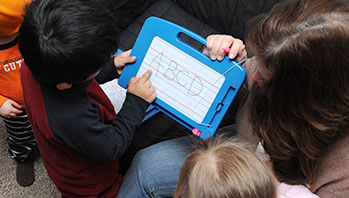- Between the Lions alphabet chart
- chart paper
- letter card “Cc”
- modeling clay
- pipe cleaners
- straight edge
- curved
- lowercase
- straight
- uppercase
MA Standards:
Foundational Skills/RF.PK.MA.1.d: Recognize and name some uppercase letters of the alphabet and the lowercase letters in one’s own name.
Head Start Outcomes:
Literacy Knowledge/Alphabet Knowledge: Recognizes that the letters of the alphabet are a special category of visual graphics that can be individually named.
PreK Learning Guidelines:
English Language Arts/Reading and Literature 7: Develop familiarity with the forms of alphabet letters, awareness of print, and letter forms.
Letter Shaping (“Cc”)

© Commonwealth of Massachusetts, Department of Early Education and Care (Jennifer Waddell photographer). All rights reserved.
Skill Focus: Fine Motor Skills, Letter Formation, Letter Recognition, Vocabulary
Educator Prep: Print out the Between the Lions alphabet chart or create an alphabet chart on chart paper.
Display the letter “Cc” card. Trace over both the lowercase and uppercase “Cc.” Show children how to use the materials to form the letters.
- Hold up a straight edge. Explain that when we write letters, sometimes we use straight lines. Trace the straight edge onto the chart paper to demonstrate.
- Then say, For other letters, such as “Cc,” instead of a straight line we use a curved line.
- Model making a curved line on a whiteboard or chart paper. Say, Let’s practice. First, watch me make a straight line in the air. (Move your hand in a straight line.) Now ask children to repeat. Then say, Now watch me make a curved line. (Move your hand to make a curved line.) Ask children to repeat. Say, If we know how to make a curve, we can make the letter “Cc.” Let’s use a pipe cleaner to make the letter “Cc.” Work with children to shape the letter with a pipe cleaner then have them shape letters with modeling clay.
Adaptation: For younger children you may want to adapt the materials used for shaping if younger children will be working individually. Use dough in place of modeling clay.
English Language Learners: If children are having trouble understanding what is meant by straight and curved lines, draw examples for them, or guide their fingers as they trace the outline of objects with curved lines such as a button. Have children trace the drawn lines with their fingers as you have them say the words straight and curved.
